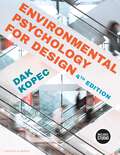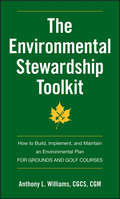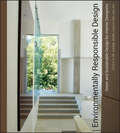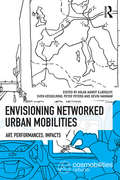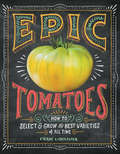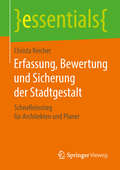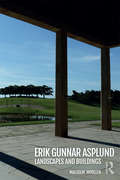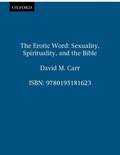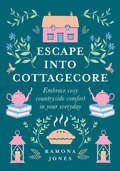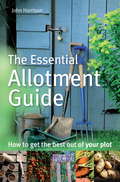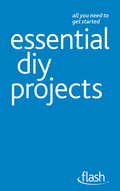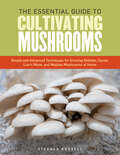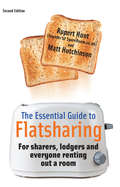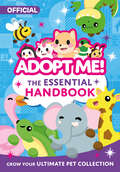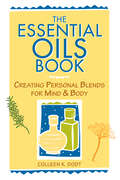- Table View
- List View
Environmental Psychology for Design: - with STUDIO
by Dak KopecHow does a room affect an occupant's behavior and well-being? How does a building influence its residents' health? Environmental Psychology for Design, 4th Edition, explores these questions with an in-depth look at psychosocial responses to the built environment. Awarded the 2006 ASID Joel Polsky Prize, the first edition served as an introduction to the discipline of environmental psychology and inspired readers to embrace its key concepts and incorporate them into their practice. This 4th edition continues to analyze the interaction between environments and human behavior and well-being, while exploring how individual differences related to age, gender, and cultural background impact that interaction. More discussions on logic formation and argumentation and how these ideas pertain to biological, psychological and sociological paradigms of thought have been incorporated. Additionally, chapters have been rearranged to allow for better content flow, and the emphasis will shift from person specific chapters to be place specific (i.e., schools for youth, long-term care facilities, and more). Ethical Consideration and Pandemic Ponderings box features are included throughout. New to this Edition-Chapters have been reorganized to be more location-centric (ie: schools, long-term care facilities, etc)-Ethical Consideration and Pandemic Ponderings box features included for further discussion of timely topics STUDIO Features Include -Study smarter with self-quizzes featuring scored results and personalized study tips -Review concepts with flashcards of terms and definitions Instructor Resources-Instructor's Guide to help integrate the text into your classroom-PowerPoint Slides for every chapter
The Environmental Stewardship Toolkit: How to Build, Implement and Maintain an Environmental Plan for Grounds and Golf Courses
by Anthony L. WilliamsA comprehensive, one-stop guide to environmental stewardship for golf courses and grounds This highly practical guide covers the full complement of tools green industry professionals need to create a successful environmental program on golf courses and grounds. Written by a leading golf course superintendent and grounds manager, The Environmental Stewardship Toolkit offers a comprehensive analysis of all relevant issues, including environmental management, resource management, community engagement, and document management. The emphasis throughout is on the development of programs that are both sustainable and practical, combining the protection and renewal of environmental systems with a workable business plan. Regulatory issues as well as concerns of owners, customers, and the community at large are also addressed. Clear, pragmatic, up-to-the-minute coverage includes: Numerous illustrations, photos, and customizable templates and checklists that readers can use in their own projects A system for sorting projects into green, greener, and greenest in order to tailor implementation for different budgets and project complexity An in-depth look at site assessment, water quality and conservation, integrated pest management, and wildlife habitat management Guidance for developing green public relations and communications skills to promote the project in the community Field-tested procedures for building a state-of-the art documentation system for capturing, organizing, and disseminating information A must-read for golf course superintendents, irrigation specialists, turfgrass specialists, and grounds managers, The Environmental Stewardship Toolkit is also useful for landscape architects and designers, grounds owners, developers, builders, contractors, and anyone wishing to be on the cutting edge of sustainability in the green industry.
The Environmental Stewardship Toolkit: How to Build, Implement and Maintain an Environmental Plan for Grounds and Golf Courses
by Anthony L. WilliamsA comprehensive, one-stop guide to environmental stewardship for golf courses and grounds This highly practical guide covers the full complement of tools green industry professionals need to create a successful environmental program on golf courses and grounds. Written by a leading golf course superintendent and grounds manager, The Environmental Stewardship Toolkit offers a comprehensive analysis of all relevant issues, including environmental management, resource management, community engagement, and document management. The emphasis throughout is on the development of programs that are both sustainable and practical, combining the protection and renewal of environmental systems with a workable business plan. Regulatory issues as well as concerns of owners, customers, and the community at large are also addressed. Clear, pragmatic, up-to-the-minute coverage includes: Numerous illustrations, photos, and customizable templates and checklists that readers can use in their own projects A system for sorting projects into green, greener, and greenest in order to tailor implementation for different budgets and project complexity An in-depth look at site assessment, water quality and conservation, integrated pest management, and wildlife habitat management Guidance for developing green public relations and communications skills to promote the project in the community Field-tested procedures for building a state-of-the art documentation system for capturing, organizing, and disseminating information A must-read for golf course superintendents, irrigation specialists, turfgrass specialists, and grounds managers, The Environmental Stewardship Toolkit is also useful for landscape architects and designers, grounds owners, developers, builders, contractors, and anyone wishing to be on the cutting edge of sustainability in the green industry.
Environmentally Responsible Design: Green and Sustainable Design for Interior Designers
by Louise JonesAt last, there's an authoritative guide to help interior designers apply green- building and sustainability applications to their environments. Sustainable Interior Design expertly introduces the principles of environmentally responsible design for interior environments. This useful reference provides beginning designers and experienced professionals alike with a comprehensive survey that coverers everything from theoretical approaches to current practices. It helps designers understand the environmentally responsible approach and make design decisions that are ethical and do not harm the world?s environment.
Envisioning Better Communities: Seeing More Options, Making Wiser Choices
by Randall ArendtThe author's work has shaped a generation of planners, designers, and landscape architects. In this book, the author brings his insights to a broader public, with a profusely illustrated demonstration of how local officials, planning commissioners, and everyday citizens can work to make their communities more attractive, more habitable, and more sustainable. Despite the widespread acceptance of good design and planning principles throughout the professions, too many of our towns and rural areas remain needlessly ugly and inefficient. In side by side comparisons of similar places and kinds of buildings, the author shows that we need not live amid sprawling, characterless visual blight. Simple design choices and effective municipal decisions can have tremendous impacts on the quality of our communities. Written in the author's well-known clear, accessible, nontechnical style, this book creates a sense of hope for those who face the everyday challenges of working with developers and landowners to create places that make economic, environmental, and aesthetic sense. The author shows us that with diligence, thoughtfulness, and care, we can make our communities better in countless ways.
Envisioning Better Communities: Seeing More Options, Making Wiser Choices
by Randall ArendtThe author's work has shaped a generation of planners, designers, and landscape architects. In this book, the author brings his insights to a broader public, with a profusely illustrated demonstration of how local officials, planning commissioners, and everyday citizens can work to make their communities more attractive, more habitable, and more sustainable. Despite the widespread acceptance of good design and planning principles throughout the professions, too many of our towns and rural areas remain needlessly ugly and inefficient. In side by side comparisons of similar places and kinds of buildings, the author shows that we need not live amid sprawling, characterless visual blight. Simple design choices and effective municipal decisions can have tremendous impacts on the quality of our communities. Written in the author's well-known clear, accessible, nontechnical style, this book creates a sense of hope for those who face the everyday challenges of working with developers and landowners to create places that make economic, environmental, and aesthetic sense. The author shows us that with diligence, thoughtfulness, and care, we can make our communities better in countless ways.
Envisioning Networked Urban Mobilities: Art, Performances, Impacts (Networked Urban Mobilities Series)
by Kevin Hannam Sven Kesselring Aslak Aamot Kjaerulff Peter PetersEnvisioning Networked Urban Mobilities brings together scientific reflections on the relations of art and urban mobilities and artistic research on the topic. The editors open the book by setting out the concept grounded in the exhibition curated by Aslak Aamot Kjærulff and refers to earlier work on mobilities and art generated by the Cosmobilities Network. This third volume has two sections, both consisting of short papers and illustrations. The first section is based on artists who were part of the conferences' art exhibition, and the second part is based on theoretical reflections on art and artists.
Envisioning Networked Urban Mobilities: Art, Performances, Impacts (Networked Urban Mobilities Series)
by Kevin Hannam Sven Kesselring Aslak Aamot Kjaerulff Peter PetersEnvisioning Networked Urban Mobilities brings together scientific reflections on the relations of art and urban mobilities and artistic research on the topic. The editors open the book by setting out the concept grounded in the exhibition curated by Aslak Aamot Kjærulff and refers to earlier work on mobilities and art generated by the Cosmobilities Network. This third volume has two sections, both consisting of short papers and illustrations. The first section is based on artists who were part of the conferences' art exhibition, and the second part is based on theoretical reflections on art and artists.
Epic Tomatoes: How to Select and Grow the Best Varieties of All Time
by Craig LeHoullierSavor your best tomato harvest ever! Craig LeHoullier provides everything a tomato enthusiast needs to know about growing more than 200 varieties of tomatoes, from planting to cultivating and collecting seeds at the end of the season. He also offers a comprehensive guide to various pests and tomato diseases, explaining how best to avoid them. With beautiful photographs and intriguing tomato profiles throughout, Epic Tomatoes celebrates one of the most versatile and delicious crops in your garden.
Epiphytic bromeliad (large print)
by RnibThis image shows an Epiphytic bromeliad growing on the branch of a tree. This is the Aechmea cylindrata variety, which can grow up to 50 centimetres high.There is a locator dot shown, which will be at the top left of the page when the image is the correct way up.You will find a tree branch going across the bottom of the page. Halfway along, the roots of the bromeliad are wrapped around it.Up from here are the plans long, pointed, green leaves growing up and out to the left and right. The plant stores the water that gathers in the overlapping leaf-base. At the top centre of the image is the bromeliads flower spike. It has individual flowers growing out to the left and right from a central stem. The flowers are magenta near the stem and pale blue at their tips. Bromeliads are native to South America. They include Pineapples and Spanish moss.
Epiphytic bromeliad (UEB contracted)
by RnibThis image shows an Epiphytic bromeliad growing on the branch of a tree. This is the Aechmea cylindrata variety, which can grow up to 50 centimetres high.There is a locator dot shown, which will be at the top left of the page when the image is the correct way up.You will find a tree branch going across the bottom of the page. Halfway along, the roots of the bromeliad are wrapped around it.Up from here are the plans long, pointed, green leaves growing up and out to the left and right. The plant stores the water that gathers in the overlapping leaf-base. At the top centre of the image is the bromeliads flower spike. It has individual flowers growing out to the left and right from a central stem. The flowers are magenta near the stem and pale blue at their tips.Bromeliads are native to South America. They include Pineapples and Spanish moss.
Epiphytic bromeliad (UEB uncontracted)
by RnibThis image shows an Epiphytic bromeliad growing on the branch of a tree. This is the Aechmea cylindrata variety, which can grow up to 50 centimetres high.There is a locator dot shown, which will be at the top left of the page when the image is the correct way up.You will find a tree branch going across the bottom of the page. Halfway along, the roots of the bromeliad are wrapped around it.Up from here are the plans long, pointed, green leaves growing up and out to the left and right. The plant stores the water that gathers in the overlapping leaf-base. At the top centre of the image is the bromeliads flower spike. It has individual flowers growing out to the left and right from a central stem. The flowers are magenta near the stem and pale blue at their tips.Bromeliads are native to South America. They include Pineapples and Spanish moss.
Erfassung, Bewertung und Sicherung der Stadtgestalt: Schnelleinstieg für Architekten und Planer (essentials)
by Christa ReicherChrista Reicher gibt einen Überblick über die Inhalte der Stadtgestalt und wie diese im planerischen Kontext im Sinne der Stadtgestaltung beeinflusst werden können. Neben einer Begriffsdefinition werden die unterschiedlichen Dimensionen der Stadtgestalt anschaulich beschrieben. In den vergangenen Jahrzehnten haben sich verschiedene Städtebauer und Stadtforscher mit der Stadtgestalt auseinandergesetzt. Hierzu werden die wichtigsten Theorien vorgestellt sowie ein Einblick in Methoden zur Erfassung und Bewertung der Stadtgestalt gewährt.Die Autorin Christa Reicher ist seit 2002 Professorin und Leiterin des Fachgebiets Städtebau, Stadtgestaltung und Bauleitplanung an der Fakultät Raumplanung der Technischen Universität Dortmund und ist Gründerin eines Planungsbüros mit Sitz in Aachen.
Erik Gunnar Asplund: Landscapes and Buildings
by Malcolm WoollenTaking an interdisciplinary approach, weaving together art, philosophy, history, and literature, this book investigates the landscapes and buildings of Swedish architect Erik Gunnar Asplund. Through critical essays and beautiful illustrations focusing on four projects, the Woodland Cemetery, the Stockholm Public Library, the Stockholm Exhibition and Asplund’s own house at Stennäs, it addresses the topic of buildings accompanied by landscapes. It proposes that themes related to landscape are central to Asplund’s distinctive work, with these particular sites forming a collection that documents an evolution in his design thinking from 1915 to 1940. The architect himself wrote comparatively little about his design intentions. However, through close reading and analysis of the selected projects as landscapes with architecture, author Malcolm Woollen argues that reflections of the history of Swedish landscape architecture and the intellectual climate in the late nineteenth and early twentieth centuries are evident in his work and help to explain the architect’s intentions. This book is a must-have for academics, advanced students and researchers in landscape architecture and design who are interested in Nordic Classicism and the works of Erik Gunnar Asplund.
Erik Gunnar Asplund: Landscapes and Buildings
by Malcolm WoollenTaking an interdisciplinary approach, weaving together art, philosophy, history, and literature, this book investigates the landscapes and buildings of Swedish architect Erik Gunnar Asplund. Through critical essays and beautiful illustrations focusing on four projects, the Woodland Cemetery, the Stockholm Public Library, the Stockholm Exhibition and Asplund’s own house at Stennäs, it addresses the topic of buildings accompanied by landscapes. It proposes that themes related to landscape are central to Asplund’s distinctive work, with these particular sites forming a collection that documents an evolution in his design thinking from 1915 to 1940. The architect himself wrote comparatively little about his design intentions. However, through close reading and analysis of the selected projects as landscapes with architecture, author Malcolm Woollen argues that reflections of the history of Swedish landscape architecture and the intellectual climate in the late nineteenth and early twentieth centuries are evident in his work and help to explain the architect’s intentions. This book is a must-have for academics, advanced students and researchers in landscape architecture and design who are interested in Nordic Classicism and the works of Erik Gunnar Asplund.
The Erotic Word: Sexuality, Spirituality, And The Bible
by David M. CarrHistorically, the Bible has been used to drive a wedge between the spirit and the body. In this provocative book, David Carr argues that it can--and should--do just the opposite. Sexuality and spirituality, Carr contends, are intricately interwoven: when one is improverished, the other is warped. As a result, the journey toward God and the life-long engagement with our own sexual embodiment are inseparable. Humans, the Bible tells us, both male and female, were created in God's image, and eros--a fundamental longing for connection that finds abstract good in the pleasure we derive from the stimulation of the senses--is a central component of that image. The Bible, particularly the Hebrew Bible, affirms erotic passion, both eros between humans and eros between God and humans. In a sweeping examination of the sexual rules of the Bible, Carr asserts that Biblical "family values" are a far cry from anything promoted as such in contemporary politics. He concludes that passionate love--our preoccupaton therewith and pursuit thereof--is the primary human vocation, that eros is in fact the flavoring of life.
Escape Into Cottagecore: Embrace Cosy Countryside Comfort In Your Everyday
by Ramona JonesFind happiness in the natural world, be fully present where you are and free yourself from the expectations of others.
The Essential Allotment Guide: How to Get the Best out of Your Plot
by John HarrisonIn recent years allotments have grown in popularity with demand far outstripping supply. John Harrison shows how to improve your chances of getting an allotment and move up the waiting list. In this all-encompassing guide, he also advises on clearing an allotment, planning what to grow and how, building compost bins, using raised beds - plus detailed instructions on growing the best vegetables and fruit.Praise for John Harrison's Vegetable Growing Month by Month:"...solid words of advice, written in a way that everyone will understand."Medwyn Williams, Chairman of the National Vegetable Society and member of the Fruit and Vegetable Committee of the Royal Horticultural Society.
Essential DIY Projects: Flash (Flash)
by DIY DoctorThe books in this bite-sized new series contain no complicated techniques or tricky materials, making them ideal for the busy, the time-pressured or the merely curious. Essential DIY Projects is a short, simple and to-the-point guide to that will teach you a number of essential projects around the house in just 96 pages. Suitable even for those who've never picked up a hammer, this is an ideal starting point for the new home-owner or tentative DIY-er.
The Essential Guide to Cultivating Mushrooms: Simple and Advanced Techniques for Growing Shiitake, Oyster, Lion's Mane, and Maitake Mushrooms at Home
by Stephen RussellWith clear instructions and step-by-step photographs, this straightforward guide shows you how to cultivate mushrooms in your own home.
The Essential Guide To Flatsharing, 2nd Edition: For sharers, lodgers and everyone renting out a room
by Matt Hutchinson Rupert HuntWhether you're looking for a flatshare or renting out a room The Essential Guide to Flatsharing has everything you need to know. If you're: * Renting out a spare room. * All about taking in a lodger; drawing contracts; the tax and financial issues; necessary preparation; advertising your room; and much more. * Looking for a flatshare. * Where to look; how to pick the best flatmates; how to keep your flatshare harmonious; how to avoid conflicts. * Finding a new flatmate. *How to advertise; picking the right person; dealing with money.
The Essential Handbook (Adopt Me!)
by Uplift GamesAn essential game companion for new players and long-time fans of the popular online game, Adopt Me!
The Essential Oils Book: Creating Personal Blends for Mind & Body
by Colleen K. DodtDiscover the fragrant world of essential oils. Herbalist Colleen K. Dodt profiles the healing and cleaning powers of dozens of oils extracted from herbs, flowers, roots, barks, and resins. This comprehensive guide includes recipes for natural cleaning products, lotions, and ointments that will keep you feeling happy and smelling great. Fill your days with stimulating scents as you learn to use essential oils to wash your dishes, soothe sunburns, combat stress, and improve the quality of your life.
